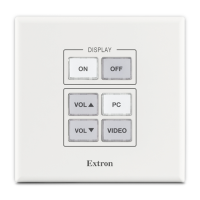MLC Plus 50/100/200 Series • Glossary 47
IP address A unique, 32-bit, binary number (12 digit decimal number, xxx.xxx.xxx.xxx) that identifies
each device or device port (an information sender and/or receiver) that is connected to
a LAN, WAN, or the Internet. IP addresses can be static (see static IP) or dynamic (see
DHCP).
IP net mask/subnet mask — See subnet mask.
MAC (Media Access Control) Address
A unique hardware number given to devices that connect to a network such as the Internet.
When a computer or networking device (router, hub, interface, and the like) is connected
to a LAN or the Internet, a table (which is used in ARP) relates the IP address of the device
to its corresponding physical (MAC) address on the LAN. This protocol allows for several
terminals or network nodes to communicate within a multi-point network, typically a local
area network (LAN).
NTP (Network Time Protocol)
NTP is an Application layer networking protocol that synchronizes clocks among computers
and other devices over networks.
Ping A utility/diagnostic tool that tests network connections. It is used to determine if the host
has an operating connection and is able to exchange information with another host.
Port number A preassigned address within a server (such as the controller) that provides a direct route
from the Application to the Transport layer or from the Transport layer to the Application of a
TCP/IP system.
SFTP (Secure File Transfer Protocol)
Similar to FTP, this protocol adds encryption and requires credentials for file transfers.
SMTP (Simple Mail Transfer Protocol)
SMTP is an Internet standard for e-mail transmission. By default, SMTP uses TCP port 25.
SMTP connections secured by SSL, known as SMTPS, default to port 465.
SNMP (Simple Network Management Protocol)
SNMP is an Application layer protocol that facilitates the exchange of basic network
management information between network devices. It helps in monitoring of operations and
factors such as bandwidth, memory usage, remote password resets, and collection of error
information. This protocol collects (and configures) information from network devices (such
as servers, hubs, switches, and routers) on an Internet Protocol (IP) network.
SSH (Secure Shell) SSH is a network protocol for secure data communication and for providing various secure
network services between two networked computers. SSH creates a secure channel
over an insecure network to connect client and server devices. It allows confidential
communications of passwords and similar data over public or otherwise insecure networks.
Static IP An IP address that has been specifically (instead of dynamically—see DHCP) assigned
to a device or system in a network configuration. This type of address requires manual
configuration of the actual network device or system and can only be changed manually or
by enabling DHCP.
Subnet — See subnetwork.
Subnet address The portion of an IP address that is specifically identified by the subnet mask as the
subnetwork.
Subnet mask A 32-bit binary number (12 digit decimal number, xxx.xxx.xxx.xxx) used on subnets (smaller,
local networks) to help routers determine which network traffic gets routed internally (within
the subnetwork) to local computers and which network traffic goes out to the rest of the
network or the Internet. It is an address mask used to identify the bits of an IP address that
are used for the subnet address. Using a mask, the router does not need to examine all
32bits, only those selected by the mask.
Subnetwork A network that is part of a larger IP network and is identified by a subnet address. Networks
can be segmented into subnetworks to provide a hierarchical, multilevel routing structure.

